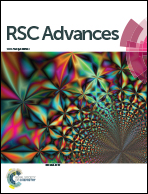Hexahapto-chromium complexes of graphene: a theoretical study†
Abstract
Chromium fragments coordinated with graphene provide a potentially powerful method for the modification of graphene. The newly reported density functional theory method, M11-L, was employed to elucidate the coordination of chromium fragments with graphene. Oligoacenes were chosen to model graphene. The radii of the centrosymmetric oligoacenes were systematically increased to find the limit required to model graphene. meta-Trisubstituted benzene coordinated chromium fragments were employed to study the electronic effect of the complexation of chromium with graphene. The movement and arrangement of the chromium fragments on graphene is also studied.


 Please wait while we load your content...
Please wait while we load your content...